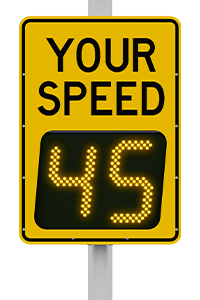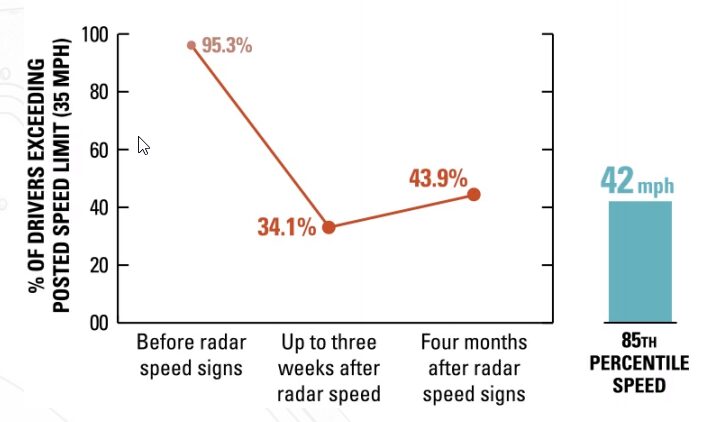MX SeriesTM
SpeedCheck® Radar Speed Signs
Reduce speeds in neighborhoods and school zones with MUTCD-compliant vehicle speed feedback signs (a.k.a. radar speed signs).

Manage speed, save lives
When vehicles speed through urban areas like school zones, residential streets, or roads under 45 mph, pedestrian fatalities skyrocket.
Effective speed management is critical—crash severity increases with vehicle speed and weight. When static signs fail, radar speed signs offer a solution, reducing speeds by 5 to 9 mph and significantly lowering risks to pedestrians.
Radar speed signs + connectivity:
SPEEDCHECK-MX
Discover an affordable radar speed sign packed with premium features.
Here’s what you get with an MX Series Radar Speed Sign:
- 3 years of free remote connectivity
- Automatic connectivity out-of-the-box
- Quick setup and local access with MX Field App™ (iOS/Android)
- Access traffic data, health status, and system programming with MX Cloud™ and MX Field App™
- Ultra-clear displays for maximum visibility, with configurable options like strobes
- Long-lasting, reliable performance

Meets MUTCD Standards

Buy America / BABA compliant

3-year system warranty

Unlock full insights with MX Cloud
- Get complete asset visibility and seamless data collection
- Program and set up alerts
- View data and charts
- Access the GPS map for asset management
- Enable proactive future planning

Every MX system ships with 3 years free remote connectivity.
With MX, connectivity isn’t an add-on. We’ve embedded it into the hardware so that it automatically connects and reports to the cloud (and a free local app) the moment it receives power.
MX Lite
Get actionable alerts and a network-wide view of your systems.
3 Years Free | $79/year at year 4
Features (Core)
- Out-of-the-box connectivity
- System alerts (email/text)
- Remote asset management with GPS map view and more
RECOMMENDED
MX Plus
Make changes to your system settings and access data from anywhere.
$99/year
All MX Lite features and
- Remote programming
- Knockdown alerts
- Data Charting
- …and more
MX Pro
Create, edit and set schedules in bulk and on-the-fly.
$249/year
All MX Plus features and
- Remote scheduling
- 5-year historical data
- Export functionality
- …and more
Radar Speed Signs: Best Practices for Placement and Use
Radar speed signs are MUTCD and Transport Canada-approved. They offer an effective, affordable, and low-maintenance alternative to sidewalks, traffic lights, or speed humps. Explore our free guide to discover best practices for placement and detection applications.
Build a SpeedCheck Radar Speed Sign
Click and choose from one of the two options below to get started

Build a SPEEDCHECK-MX
Built-in connectivity, including a free iOS/Android app and 3 years of free remote connectivity. The 12-inch digit size can be used for single or multi-lane roads, and we recommend the 15-inch digit size for express and freeways. Larger digits have better visibility.

Build a SPEEDCHECK-18
This classic model has 18-inch digits and is ideal for roads with higher posted speed limits. Call for connectivity options.

Build a SPEEDCHECK-MX
Built-in connectivity, including a free iOS/Android app and 3 years of free remote connectivity. The 12-inch digit size can be used for single or multi-lane roads, and we recommend the 15-inch digit size for express and freeways. Larger digits have better visibility.

Build a SPEEDCHECK-18
This classic model has 18-inch digits and is ideal for roads with higher posted speed limits. Call for connectivity options.


Proving Radar Speed Signs work
Several studies have examined radar speed signs’ impact on driver behavior in the short and long term. In 2002, the Texas Transportation Institute (TTI) undertook a four-month survey of seven sites where radar speed signs had been permanently installed, including a school zone, sharp horizonal curves, and approaches to signalized intersections. The findings indicated that radar speed signs reduced speeds by 9 mph in school zones within a week of installation, with this effect sustained for four months.
Carmanah’s Radar Speed Sign Product Portfolio
SPEEDCHECK-MX
Connected, solar or AC-powered radar speed signs in 12- and 15-inch digits. Includes a free iOS/Android app and 3 years of free remote connectivity.

SPEEDCHECK-18
Classic radar speed sign model features 18-inch digits, essential for roads with higher speed limits.

SPEEDCHECK-12
Classic radar speed sign model with 12-inch digits, can be powered by solar, AC or battery-only.

SPEEDCHECK-15
Classic radar speed sign model with 15-inch digits and “SLOW DOWN” message.

SPEEDCHECK-MX
Connected, solar or AC-powered radar speed signs in 12- and 15-inch digits. Includes a free iOS/Android app and 3 years of free remote connectivity.

SPEEDCHECK-18
Classic radar speed sign model features 18-inch digits, essential for roads with higher speed limits.

SPEEDCHECK-12
Classic radar speed sign model with 12-inch digits, can be powered by solar, AC or battery-only.

SPEEDCHECK-15
Classic radar speed sign model with 15-inch digits and “SLOW DOWN” message.

Additional Resources for Radar Speed Signs
Article
Radar Speed Signs Top Traffic Calming List They’re effective, they’re flexible, and they provide minimal disruption to traffic and neighborhoods. What’s not to love?
Case Study
Chandler, AZ Boosts Intersection Safety with Radar Speed Signs How one city coping with a population explosion greatly reduced the number of traffic fatalities at intersections.
Application Guide
Radar Speed Sign Application Guide Download this visual guide for the most common radar speed sign applications, including placement, sign legibility and MUTCD guidelines for additional features.
Video
School Zone Safety, Part 3: Radar Speed Signs Part 3 of our school zone safety video series focuses on solutions to help drivers self-correct their speed and slow down, increasing safety for all users.
Article
Radar Speed Signs Top Traffic Calming List They’re effective, they’re flexible, and they provide minimal disruption to traffic and neighborhoods. What’s not to love?
Case Study
Chandler, AZ Boosts Intersection Safety with Radar Speed Signs How one city coping with a population explosion greatly reduced the number of traffic fatalities at intersections.
Application Guide
Radar Speed Sign Application Guide Download this visual guide for the most common radar speed sign applications, including placement, sign legibility and MUTCD guidelines for additional features.
Get in touch
Have questions or need assistance? Connect with sales for product inquiries and quotes, support for technical issues, or visit the product support center for self-service resources.
